
In today's era of increasingly strict food safety regulations, small - scale sesame oil production enterprises often face significant challenges in equipment cleaning. These challenges can lead to cross - contamination and excessive microbial levels, seriously affecting product quality and market competitiveness. This article will comprehensively explore how a fully - enclosed sesame oil production line can address these issues and help enterprises establish a scientific and hygienic management system.
Small and medium - sized enterprises in the sesame oil production industry frequently encounter problems such as microbial over - standard and equipment residue pollution. Microbial over - standard is mainly caused by improper cleaning and long - term accumulation of residues in the equipment. Equipment residue pollution can lead to cross - contamination between different batches of products, which not only affects the taste and quality of sesame oil but also poses a threat to food safety. According to industry research, nearly 60% of small - scale sesame oil production enterprises have experienced problems related to microbial over - standard and cross - contamination.

The fully - enclosed sesame oil production line uses 304 stainless steel, which is a food - grade material. It has excellent corrosion resistance and can effectively prevent the growth of bacteria and other microorganisms. The smooth surface of 304 stainless steel also makes it easier to clean, reducing the risk of residue accumulation. Compared with ordinary carbon steel equipment, the service life of 304 stainless steel equipment can be extended by at least 3 - 5 years.
The sealing structure of the production line can effectively block air contact. By minimizing the entry of external air, the risk of microbial contamination is significantly reduced. The precision - designed sealing structure can prevent dust, bacteria, and other pollutants from entering the equipment, ensuring a sterile production environment throughout the process.
The CIP (Clean - in - Place) cleaning system is the core of the fully - enclosed production line. It can automatically clean the internal parts of the equipment without disassembling it. The system uses a specific cleaning solution and a set of well - designed cleaning procedures to ensure thorough cleaning. The CIP system can complete a cleaning cycle in about 1 - 2 hours, greatly improving cleaning efficiency.

Daily checks mainly include visual inspections of the equipment's appearance, such as checking for any signs of damage or leakage. It is also necessary to check the operation status of the CIP system, including the level of cleaning solution and the operation of pumps. These checks should be completed within 15 - 30 minutes each day.
Weekly maintenance requires a more in - depth inspection of the equipment, such as checking the tightness of the sealing parts. Monthly deep - cleaning involves a comprehensive cleaning of all parts of the equipment, including some hard - to - reach areas. A detailed operation list and key control points are provided in the following table:
| Maintenance Cycle | Operation Items | Key Control Points |
|---|---|---|
| Daily | Visual inspection, CIP system status check | No damage, normal operation of CIP |
| Weekly | Sealing part inspection | Good tightness |
| Monthly | Comprehensive deep - cleaning | No residue, thorough cleaning |
Let's look at two real - world cases. One small - scale sesame oil production enterprise did not pay attention to equipment cleaning and used ordinary carbon steel equipment. As a result, they often faced problems such as microbial over - standard and cross - contamination, which led to a significant decline in product quality and a loss of market share. On the other hand, another enterprise introduced a fully - enclosed sesame oil production line. Through strict cleaning management and regular maintenance, they not only met international food safety standards but also improved product quality and market competitiveness. Their sales volume increased by about 30% within a year.

From these cases, we can see that a scientific and effective cleaning management system is crucial for sesame oil production enterprises. By learning from successful cases and avoiding the mistakes of failed ones, enterprises can establish a reliable cleaning management system.
The fully - enclosed sesame oil production line helps customers achieve compliance with international food safety standards. By ensuring a sterile production environment, it also improves production efficiency, reduces the frequency of equipment breakdowns, and saves production costs. More importantly, it enhances brand credibility. Consumers are more likely to trust products that are produced in a clean and hygienic environment, which ultimately increases market competitiveness.
"Maintaining high - level hygiene in food production is not only a regulatory requirement but also a responsibility to consumers," says a representative from a well - known food safety authority.
We invite you to participate in a short questionnaire at the end of this article to share your thoughts on sesame oil production hygiene management. Your feedback will help us provide more targeted information.
Take action now! Download the "Sesame Oil Cleaning White Paper" to get the complete operation guide.